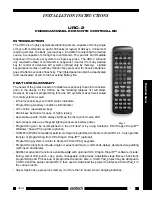
6
EA KIT160-6
*)
also available at http://www.lcd-module.de/deu/disk/disk240.zip
; Makro Demo
COM2: 115200 ; KIT ist an COM2 angeschlossen,
; Übertragung mit 115.200 Baud
;---------------------------------------------
;Konstanten definieren
AUS = 0
EIN = 1
FONT4x6 = 1
FONT5x6 = 2
FONT6x8 = 3
FONT8x8 = 4
FONT8x16= 5
;---------------------------------------------
;Fonts einbinden
Font: FONT4x6, 32,95 INTERN4x6
Font: FONT5x6, 32,158 INTERN5x6
Font: FONT6x8, 32,158 INTERN6x8
Font: FONT8x8, 32,158 INTERN8x8
Font: FONT8x16, 32,158 INTERN8x16
;---------------------------------------------
Makro: 0 ; Power-On/Reset Makro
#QC EIN ; Cursor sichtbar
#FT FONT8x16 ; Terminalfont einstellen
#UL 0,20,<EA2.BMP> ; ELECTRONIC ASSEMBLY Logo
MACRO PROGRAMMING
Single or multiple command sequences can be grouped together in macros and stored in the EEPROM.
You can then start them by using the
Run macro commands. There are 3 different types of macros:
Touch macros (1..255)
These are started when you touch a touch field (in versions with a touch panel - TP) or when you operate
an external key/matrix keyboard. Touch macro no. 0 is different: It is started when you release a key.
Port macros (0..255)
These are started when voltage is applied to IN 1..8 (only in versions with EA OPT-OPTO8I8O inputs and
outputs).
Normal macros (1..255)
These are started by means of a command via the serial interface or from another macro. A series of
macros occurring one after the other can be called cyclically (movie, hourglass, multi-page help text).
Power-on macro
Normal macro no. 0 is different: It is executed automatically after power-on. It allows you to switch off the
cursor and define an opening screen, for example. To prevent execution of power-on macro, after faulty
programming the EEPROM for example, connect RTS line (J5 , pin 6) to GND.
STORING 256 IMAGES IN THE EEPROM
To reduce the transmission times of the serial interface or to save storage space in the processor system,
up to 256 images can be stored in the internal EEPROM. They can be called using the "ESC U E"
command via the serial interface or from within a touch/port/normal macro. All the images can be used
in the Windows BMP format. They can be created and edit using widely available software such as
Windows Paint or Photoshop (must be monochrome and correct size).
CREATING INDIVIDUAL MACROS
To create your own macros, you need the following:
- The EA DISK240
*)
floppy disk, which contains a compiler, examples and fonts
- A PC with a COM1 or COM2 serial interface and approximately 500KB hard disk space
- A text editor such as WordPad or Norton Editor
To define a sequence of commands as a macro, all the commands are written to a file on the PC (e.g.
DEMO.KMC). You specify which character sets are to be
integrated and which command sequences are to be in which
macros.
Once the macros are defined, you start the program
C:>KITCOMP DEMO.KMC. This creates an EEPROM file
called DEMO.EEP, which is then automatically stored in the
display EEPROM with the baud rate entered. This only takes
a few seconds, and you can then use your user-defined
macros immediately. You will find a detailed description of
how to program macros, together with a large number of
examples, in the files DOKU.DOC (for WORD) and
DOKU.TXT (DOS) on the EA DISK240
*)
floppy disk.
WRITE PROTECTION FOR MACROS
To prevent overwriting stored macros and images close
solder bridge WP (connection VDD-WP). Please note that
baudrate is locked, too. So changing the baudrate by KITBAUD.EXE requires an open solder strap WP.






































